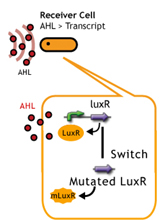Team:Chiba/Experiments:LuxR mutant
From 2008.igem.org
(Difference between revisions)
(→Method) |
(→Experiment) |
||
| Line 36: | Line 36: | ||
===Experiment=== | ===Experiment=== | ||
| - | + | Sender; LuxI plasmid transformed into E.coli strains (JW1908) | |
| - | + | Receiver; LuxR-gfp plasmid transformed into E.coli strains (JW1908) | |
| + | Culture/ Cndn. | ||
| + | |||
| + | 1. Both Sender and Receiver (+/- Mutation) were inoculated into small (2mL) culture and was shaken separately for 12h (at 37C) | ||
| + | 2. Inoculated into flesh media, shaken until cell density hit 2.0 in OD600 | ||
| + | 3. Washed the cell and re-suspended. Cell density checked. | ||
| + | 4. Mixed Sender and Receiver (Sender/Receiver 1000μl/1000μl). | ||
| + | 5. Incubated at 30°C. | ||
| + | 6. Time-chased the fluorescence (485nm(excitation) and 527nm(emission)) by gfp. | ||
{| class="tbl" | | {| class="tbl" | | ||
|- | |- | ||
Revision as of 01:46, 30 October 2008
| Home | The Team | The Project | Parts Submitted to the Registry | Reference | Notebook | Acknowledgements |
|---|
LuxR mutant (Under Planning)
Design
|
|
Collins et.al. described the hyper-sensitive variants of luxR to AHL.(1) CollonsらとKockらによって、LuxRに変異を入れることでLuxRのAHLに対する感受性を変えることができると報告されている。(1),(2)
- Ile45PheとするとAHLに対する感受性が約10倍上昇する(1)
- Leu42AlaとするとAHLに対する感受性が1/15に減少する(2)
- Leu42SerとするとAHLに対する感受性が1/1000に減少する(2)
Experiment
Sender; LuxI plasmid transformed into E.coli strains (JW1908) Receiver; LuxR-gfp plasmid transformed into E.coli strains (JW1908)
Culture/ Cndn.
1. Both Sender and Receiver (+/- Mutation) were inoculated into small (2mL) culture and was shaken separately for 12h (at 37C) 2. Inoculated into flesh media, shaken until cell density hit 2.0 in OD600 3. Washed the cell and re-suspended. Cell density checked. 4. Mixed Sender and Receiver (Sender/Receiver 1000μl/1000μl). 5. Incubated at 30°C. 6. Time-chased the fluorescence (485nm(excitation) and 527nm(emission)) by gfp.
|
|
| [http://partsregistry.org/Part:BBa_S03623 BBa_S03623] |
|
|
Method
- Transformed sender (Ptet-luxI), mutant LuxR Receiver (Ptet-mLuxR-Plux-GFP) and WT LuxR Receiver into E coli strains (JW1908)
- Inoculated Sender, WT Receiver (wild type luxR/BW⊿FliC) and mutated Receiver (1point mutation/BW⊿FliC) in liquid media for 12 h at 37℃.
- Inoculated again in liquid media upto about OD600=2 at 37℃
- Washed Senders and receiver.
- Mixed them. (Sender:Receiver=1000μL:1000μL)
- Incubated at 30°C.
- Measured intensity of green fluorescence(485 nm(excitation) and 527 nm(emission)) at regular time intervals.
Reference
- Collins et.al. Directed evolution of Vibrio fischeri LuxR for increased sensitivity to a broad spectrum of acyl-homoserine lactones. Mol. Microbiol. 55, 712–723 (2005)
- B.Koch et.al.:The LuxR receptor: the sites of interaction with quorum-sensing signals and inhibitors. Microbiol. 2005 Nov;151(Pt 11):3589-602.
| Home | The Team | The Project | Parts Submitted to the Registry | Notebook |
|---|
 "
"




